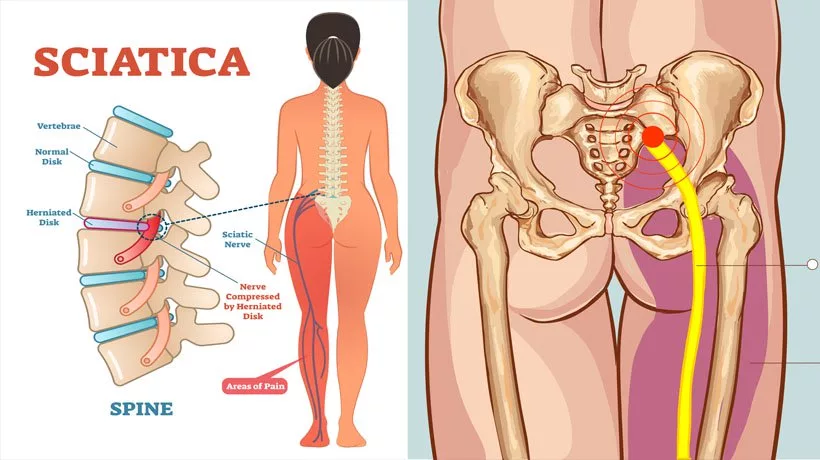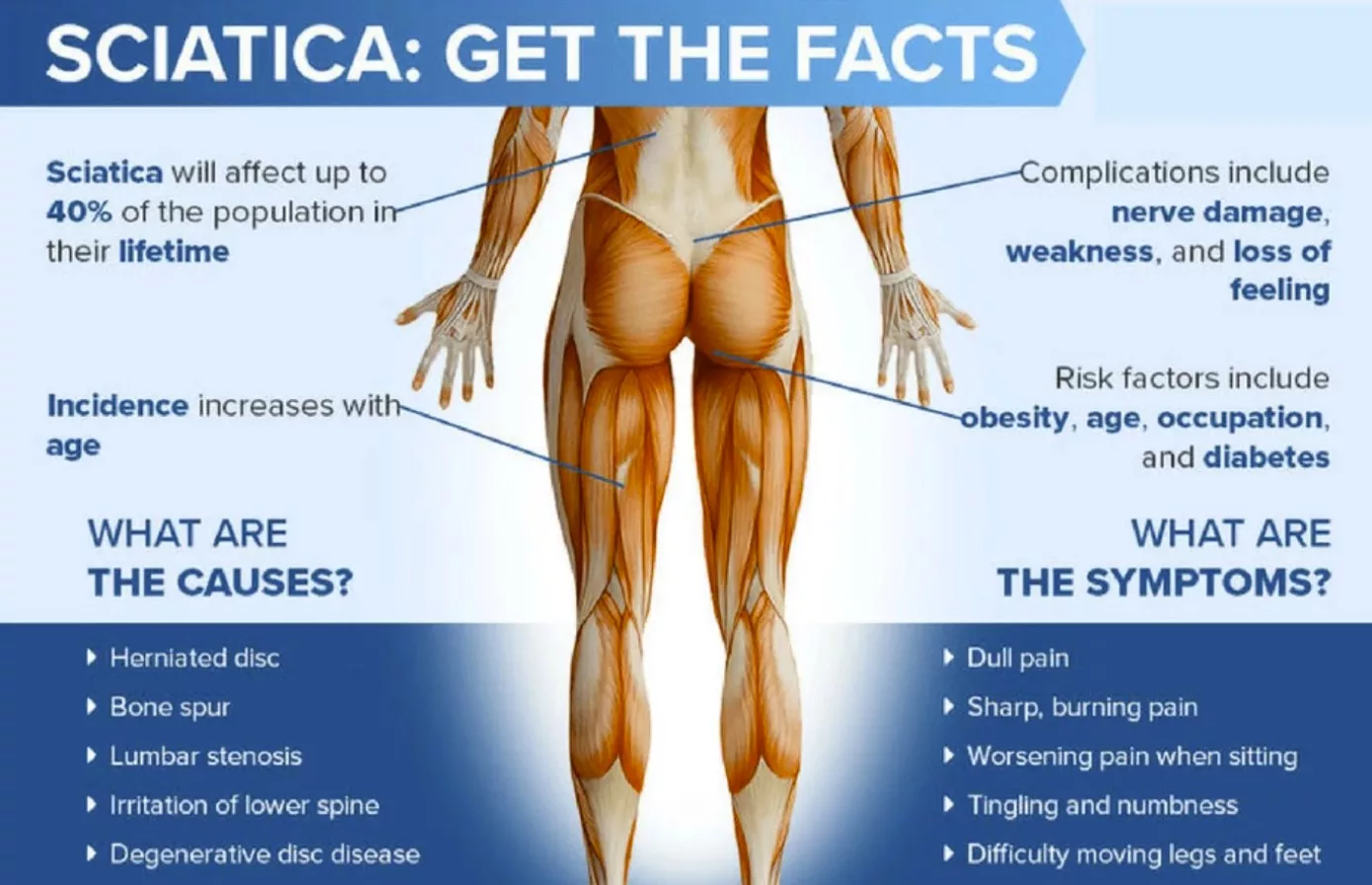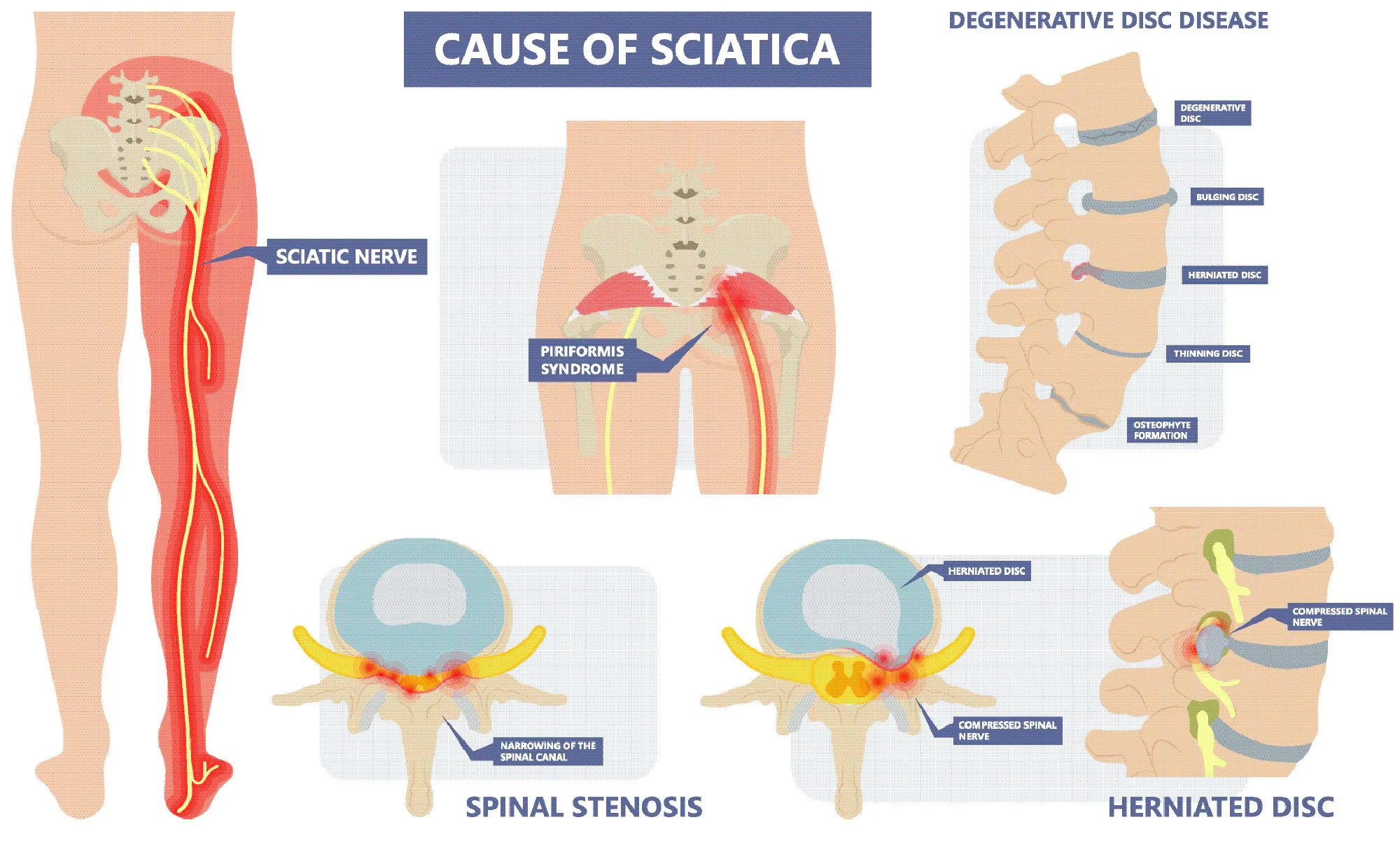How to Cure Sciatica Permanently: A Comprehensive Guide
Sciatica is a common and debilitating condition that affects millions of people worldwide. It is characterized by pain, numbness, or tingling that radiates from the lower back down one or both legs, often following the path of the sciatic nerve. This condition can significantly impact your quality of life, making even simple tasks like walking or sitting painful and uncomfortable. While sciatica can be challenging to live with, the good news is that there are ways to effectively treat and even cure it permanently. In this comprehensive guide, our major focus will be on how to cure sciatica permanently. Moreover, we will explore the causes, symptoms, and a variety of treatment options for sciatica. We will also delve into natural remedies, lifestyle changes, and preventive measures that can help you find lasting relief and potentially cure sciatica for good.
What is Sciatica?

Sciatica is not a standalone condition but rather a symptom of an underlying issue. To embark on the path toward a permanent cure, we must first understand the fundamentals of sciatica: Sciatica refers to pain that originates in the sciatic nerve, a long nerve that runs from the lower back, through the buttocks, and down each leg. Sciatica typically manifests as pain, which can vary in intensity from a mild ache to severe, debilitating discomfort. Other common symptoms include tingling, numbness, and weakness in the leg or foot.
How Common is Sciatica in United States?

Sciatica is a very common condition. About 40% of people in the United States experience some form of sciatica during their lifetime. It rarely happens before age 20 unless it’s injury-related. “People who suffer from acute or chronic back pain tend to be more susceptible to sciatica,” says Dr. Jeffrey N. Katz, professor of medicine and orthopedic surgery at Harvard Medical School.
Causes of Sciatica

To effectively address and cure sciatica, it’s crucial to identify the root causes. Sciatica is often caused by compression or irritation of the sciatic nerve, which is the longest and widest nerve in the human body. This compression can result from various underlying conditions or factors.
Here are some of the common causes of sciatica:
Herniated Disc (Bulging Disc)
One of the most frequent causes of sciatica is a herniated disc, also known as a bulging or slipped disc. This occurs when the soft inner core of a spinal disc pushes through the tough outer layer and presses against the sciatic nerve. The compression of the nerve leads to pain and other sciatic symptoms.
Spinal Stenosis
Spinal stenosis is a condition where the spinal canal narrows, putting pressure on the nerve roots, including the sciatic nerve. This narrowing can occur due to age-related changes in the spine or conditions like osteoarthritis.
Piriformis Syndrome
The piriformis muscle, located in the buttocks, can irritate or compress the sciatic nerve if it spasms or tightens. This condition is known as piriformis syndrome and is a less common cause of sciatica.
Degenerative Disc Disease
Over time, the spinal discs can naturally degenerate or wear down, which may lead to decreased disc height and the potential for nerve compression. This is particularly common in older adults.
Spondylolisthesis
Spondylolisthesis occurs when one vertebra slips forward over another vertebra. This can result in the displacement of the vertebrae and put pressure on the nearby nerve roots, including the sciatic nerve.
Muscle Imbalances
Muscle imbalances in the lower back and buttocks can contribute to sciatica. Tight or overactive muscles can compress the sciatic nerve, while weak muscles may fail to provide adequate support to the spine.
Trauma or Injury
Accidents, falls, or direct trauma to the lower back or buttocks can cause sciatica if they result in nerve compression or irritation.
Tumors or Growth
In rare cases, tumors or abnormal growths in the spine or nearby structures can put pressure on the sciatic nerve, leading to sciatica.
Infection or Inflammation
Infections or inflammatory conditions affecting the spine, such as spinal infections or conditions like ankylosing spondylitis, can lead to sciatica if they cause inflammation and compression of the nerve.
Obesity
Excess body weight, especially in the abdominal area, can increase the pressure on the lower back and contribute to sciatica by compressing the nerve.
It’s important to note that the severity and duration of sciatica symptoms can vary widely depending on the underlying cause and individual factors. Some people may experience mild, intermittent pain, while others may have severe and persistent symptoms. Additionally, treatment for sciatica will often focus on addressing the specific cause of the nerve compression or irritation, so an accurate diagnosis is crucial for effective management and relief. If you suspect you have sciatica or are experiencing symptoms, it’s essential to seek medical evaluation and guidance for appropriate diagnosis and treatment.
Risk Factors of Sciatica

Several risk factors can increase the likelihood of developing sciatica, a condition characterized by pain and discomfort along the sciatic nerve’s path. Understanding these risk factors can help individuals take preventive measures and make lifestyle choices that reduce their risk of developing sciatica.
Here are some common risk factors associated with sciatica:
- Age: As we age, spinal discs naturally degenerate and become more susceptible to herniation.
- Obesity: Excess weight can put added stress on the spine and increase the risk of disc herniation.
- Occupation: Jobs that involve heavy lifting, prolonged sitting, or twisting motions may increase the likelihood of developing sciatica.
Conventional Treatments of Sciatica

How to cure sciatica permanently? Conventional treatments for sciatica aim to alleviate pain, reduce inflammation, and address the underlying cause of nerve compression or irritation. The choice of treatment depends on the severity of the symptoms and the specific cause of sciatica.
Here are some common conventional treatments for sciatica:
Medical Evaluation
The first step toward a cure for sciatica is a thorough medical evaluation. Your healthcare provider will perform a physical examination and may recommend diagnostic tests, such as X-rays, MRI scans, or CT scans, to pinpoint the underlying cause of your sciatica.
Pain Medication
Over-the-counter pain relievers, such as ibuprofen or acetaminophen, can offer temporary relief from sciatic pain. If the pain is severe, your doctor may prescribe stronger medications or muscle relaxants to manage symptoms.
Physical Therapy
Physical therapy is a cornerstone of sciatica treatment. A physical therapist can devise a personalized exercise regimen that targets strengthening the muscles supporting your spine, enhancing flexibility, and relieving pressure on the sciatic nerve.
Holistic and Natural Remedies for Sciatica

Holistic and natural remedies for sciatica can complement conventional treatments or serve as standalone options for managing and alleviating symptoms. These approaches focus on reducing inflammation, improving muscle flexibility and strength, and promoting overall spinal health. It’s essential to consult with a healthcare professional before starting any new treatment, especially if you have underlying medical conditions or are taking medications.
How to cure sciatica permanently? Here are some holistic and natural remedies for sciatica:
Chiropractic Care
Chiropractic adjustments aim to improve spinal alignment, alleviate nerve pressure, and provide relief from sciatic pain. Many people find significant relief through regular chiropractic sessions.
Acupuncture
Acupuncture involves the insertion of thin needles into specific points on the body to stimulate healing and reduce pain. Some studies suggest that acupuncture can be effective in treating sciatica.
Yoga and Stretching
Gentle yoga poses and stretching exercises can improve flexibility, reduce muscle tension, and alleviate sciatic pain. Practices like yoga and Pilates can be particularly beneficial for individuals with sciatica.
Massage Therapy
Massage therapy can relax tense muscles, improve blood circulation, and reduce sciatic pain. Deep tissue massage and trigger point therapy are often used for this purpose.
Heat and Cold Therapy
Applying heat or cold packs to the affected area can provide temporary relief from pain and reduce inflammation. Many individuals find alternating between hot and cold packs to be particularly effective.
Herbal Remedies and Supplements
Some herbs and supplements, such as turmeric, devil’s claw, and magnesium, are believed to possess anti-inflammatory properties and may help reduce sciatic pain.
Lifestyle Modifications
Incorporating lifestyle changes can contribute to long-term sciatica relief, including maintaining a healthy weight, practicing good posture, and avoiding prolonged periods of sitting.
Mind-Body Techniques
Stress can exacerbate sciatic pain. Mindfulness meditation, relaxation techniques, and biofeedback can help manage stress and reduce the perception of pain.
Dietary Choices
A balanced diet rich in anti-inflammatory foods, such as fruits, vegetables, and omega-3 fatty acids, can potentially reduce inflammation and support overall health.
It’s essential to consult with a healthcare provider before starting any new treatment or supplement regimen, especially if you have underlying medical conditions or are taking medications. Additionally, while these holistic approaches can be effective for some, individual results may vary.
Preventing Sciatica Recurrence

Preventing the recurrence of sciatica is crucial for long-term well-being and quality of life. How to Cure Sciatica Permanently? After successfully managing an episode of sciatica, it’s essential to take steps to minimize the risk of it coming back.
Here are some strategies to help prevent the recurrence of sciatica:
Maintain a Healthy Weight
Excess body weight, especially around the abdomen, can put added stress on the lower back and increase the risk of sciatica. Maintain a healthy weight through a balanced diet and regular exercise.
Exercise Regularly
Engage in a consistent exercise routine that focuses on strengthening the muscles supporting the spine, improving flexibility, and enhancing overall fitness. Activities like walking, swimming, and yoga can be particularly beneficial.
Practice Good Posture
Pay attention to your posture, both when sitting and standing. Use ergonomic chairs and support devices if needed to maintain proper alignment and reduce strain on the spine.
Lift Properly
When lifting heavy objects, use proper lifting techniques. Bend your knees, keep your back straight, and use the strength of your legs to lift, rather than putting excessive stress on your lower back.
Take Breaks
If your job or daily activities involve prolonged sitting or standing, make an effort to take regular breaks to stretch and change positions. Avoid sitting for extended periods without breaks.
Stay Active During Recovery
If you’ve experienced sciatica in the past and are in recovery, don’t become sedentary. Continue to engage in low-impact activities that your healthcare provider recommends to maintain muscle strength and flexibility.
Avoid Smoking
Smoking can reduce blood flow to the spinal discs, impairing their ability to heal and recover from injuries. Quitting smoking can improve overall spine health.
Hydrate and Maintain Nutrition
Proper hydration and a balanced diet can support the health of spinal discs and tissues. Drinking enough water helps maintain disc height and spinal fluid circulation.
Strengthen Core Muscles
A strong core helps stabilize the spine and reduce the risk of injury. Incorporate core-strengthening exercises into your fitness routine.
Avoid High-Impact Activities
High-impact activities like running and jumping can place significant stress on the spine. If you are prone to sciatica or have a history of it, consider low-impact exercises that are gentler on the back.
Manage Stress
Chronic stress can exacerbate pain and potentially contribute to sciatica. Practice stress-reduction techniques such as meditation, deep breathing, or mindfulness to manage stress effectively.
Regular Check-Ups
Schedule regular check-ups with your healthcare provider to monitor your spine’s health, especially if you have a history of spinal conditions or sciatica.
Proper Mattress and Pillow
Ensure that your mattress and pillows provide adequate support for your spine. An ergonomic sleeping environment can contribute to spinal health.
Stay Informed
Educate yourself about sciatica, its causes, and preventive measures. Understanding the condition can help you make informed choices about your lifestyle and activities.
Listen to Your Body
Pay attention to any signs or symptoms of discomfort, even if they are mild. Addressing minor issues promptly can prevent them from worsening into more significant problems.
It’s important to remember that while these strategies can help reduce the risk of sciatica recurrence, there are no guarantees. Each individual’s experience with sciatica is unique, and the effectiveness of preventive measures may vary. If you experience any symptoms or concerns related to sciatica, consult with a healthcare professional for guidance and personalized recommendations to maintain a healthy spine and minimize the risk of recurrence.
Conclusion: How to Cure Sciatica Permanently?
How to Cure Sciatica Permanently? While sciatica can be a formidable adversary, it is not insurmountable. By understanding the underlying causes, seeking professional medical advice, and exploring a combination of conventional and holistic treatments, you can pave the way to a permanent cure. Prevention, too, plays a pivotal role in maintaining a sciatica-free life. Remember that each person’s journey to permanent relief may differ, so be patient, stay informed, and consult with healthcare professionals along the way. With dedication and the right strategies, lasting relief from sciatica is attainable, and you can regain your mobility and enjoy life to the fullest.
Call Now +1-407-434-7246
If you have suffered any type of injury or have been experiencing pain that just won’t go away regardless of what you do, then all you have to do is call and speak with our friendly staff. Find Best Sciatica Chiropractor in Orlando, Florida. Our team can help you get the treatment you need and ensure that the pain you experience is alleviated – once and for all.
We are proud to serve the areas of Orlando, Altamonte Springs, Haines City, Plant City, Kissimmee, Winter Haven, and Ocala.
Contact us for Chiropractor near me in Orlando, Florida for an Appointment Today.
Is sciatica 100% curable?
Regardless of the cause, about 90% of people with sciatica will get better without surgery - most of them in just a few weeks. You can start treating your sciatica at home. In fact, home treatment may be all you need, especially if you know that your sciatica is caused by an injury or pregnancy.
Can I treat sciatica myself?
Easing the extreme pain of sciatica doesn't always require an extreme treatment approach. Relieving sciatic nerve pain at home with gentle exercise, ice and heat therapy, proper posture, and medication may go along way to speed your recovery.
Is sciatica serious?
Although the pain associated with sciatica can be severe, most cases clear up with treatment in a few weeks. People who have severe sciatica and serious leg weakness or bowel or bladder changes might need surgery.
What is the main cause of sciatica?
Sciatica most commonly occurs in people between the ages of 30 and 50 years. It is pain that starts along your sciatic nerve and spreads down your buttock and the back of 1 thigh. It is usually caused by a herniated (or bulging) disk in your spine that presses on your sciatic nerve.
Is massage good for sciatica?
Massage therapy can be an important part of your sciatica treatment plan - providing temporary but effective pain relief, stimulating your body to produce natural pain-relieving hormones, and enhancing the body's own healing abilities. A massage can also provide an overall relaxing and enjoyable experience.




